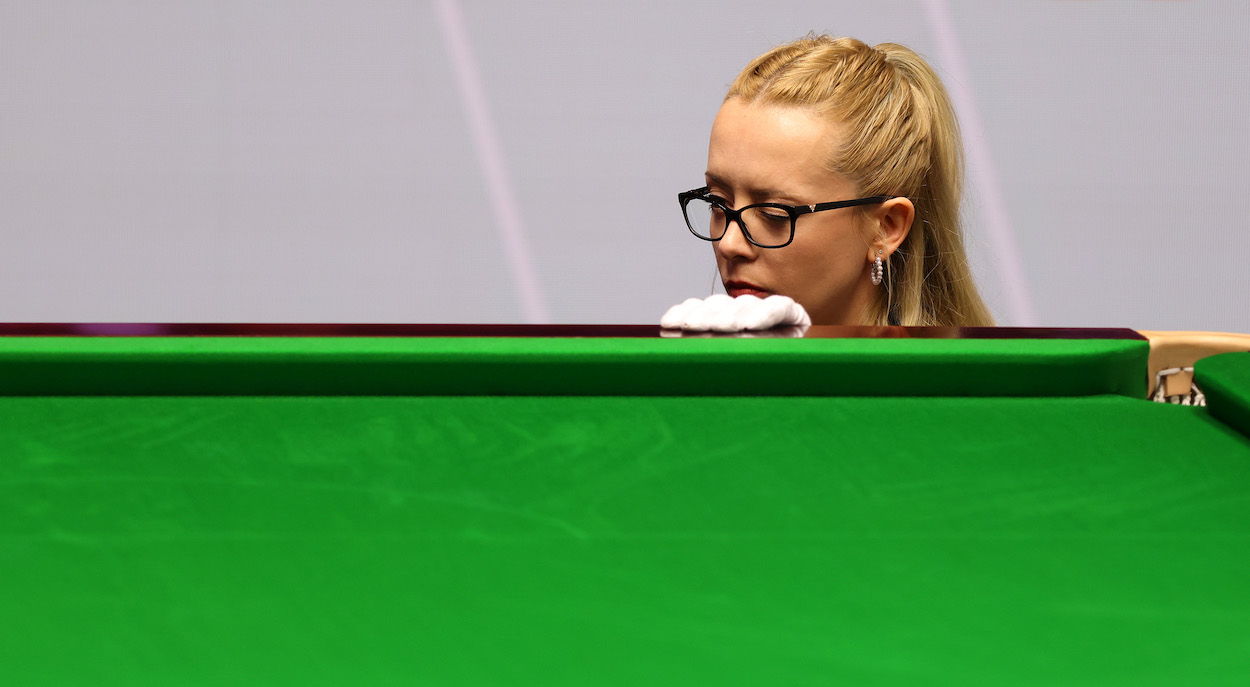Anyone who flicks through their television channels this Bank Holiday weekend will almost certainly glimpse the final of the World Snooker Championship. Played over Sunday and Monday at Sheffield’s Crucible, the 35-frame marathon is snooker’s answer to Test Cricket. And as one of the few sporting events the Beeb still has the rights to, it still gets blanket coverage – if only on graveyard slots on BBC2.
A glimpse, though, is about as much as many people bother with these days. Snooker is a long way from its mid-1980s heyday, when 18 million Brits tuned in to watch Dennis Taylor beat Steve Davis in the 1985 Crucible showdown.
I am indeed one of those sad middle-aged men you see in live snooker audiences
Indeed, those battling it out this weekend are hardly household names. With Ronnie O’Sullivan and John Higgins already knocked out, the two finalists are Kyren ‘The Warrior’ Wilson and Jak Jones, aka The Silent Assassin. No, me neither. The winner will likely get just the briefest of mentions in the national news – unless some Just Stop Oil loon throws orange powder all over the table again, as happened during last year’s tournament.
Snooker’s fortunes contrast starkly with its pub sports rival darts, which reached cult status after 17-year-old Luke ‘The Nuke’ Littler’s exploits in January’s World Darts Championship. Sure, even the runner-up at the Crucible will still trouser £200,000 prize money – the same amount Littler folded into his tracksuit bottoms at Ally Pally. But the runner up is unlikely to be discussed on Radio 4’s Today programme, or profiled by posh broadsheet feature writers. Let alone be able to sell their sweaty old match shirts for £800 a pop.
The triumph of arrows over cues, though, isn’t just down to the success of one kebab-loving 17-year-old. Way before Littler-mania, darts had already made efforts to remarket itself, turning fixtures at Ally Pally into fancy dress parties, where the crowd is as much part of the entertainment as the players. It has become, quite literally, a spectator sport, where half the fun is dressing up as a Teletubby and getting sloshed (or watching other people doing so).
Snooker, by contrast, remains as buttoned-up as it did in the days of Pot Black. The players still wear evening dress. The commentators are still whispering Ted Lowes rather than hyperbolising Sid Waddells. The refs still tick spectators off for making the slightest notice. And that’s just the telly version. The live version is even worse, I can attest, having attended January’s UK Snooker Masters, which began at Ally Pally just days after Littler’s triumph there.
Yes, you read that right. I am indeed one of those sad middle-aged men you see in live snooker audiences, dressed not in Teletubby costumes but M&S polos and cardies. All I can say my defence is that unlike some of darts’ new fans – and certain football-bore MPs – this is not born of some desire to burnish my faux-proletarian credentials.
For despite its backstreet image, snooker has long had a big middle-class following. Part of its rise in the 1980s was as a respectable, better-dressed alternative to football, then rife with hooliganism. But its heyday also won it a new fan base in suburbia, as a generation of kids seeking to be Alex Higgins bought mini six-foot snooker tables, which could fit in the average semi-detached home. For bookish, wimpy kids like me, who didn’t like the rough-and-tumble of soccer or rugby, it was the perfect softies’ sport. And, courtesy of people like Jimmy White, a passably cool one too.
I’ve remained a snooker fan ever since, not that I talk about it much (present company excepted). Unlike football bores, we snooker fans have enough humility to realise that not everybody shares our chosen passion. But one thing I’d never done was actually attend a match. So it was with much anticipation that my brother, his pal and I finally coughed up £45 each for a round of the UK Masters last January. In one way, we were very lucky. The afternoon session featured Ronnie O’Sullivan, which is a bit like turning up to Wimbledon and seeing Andy Murray. But as a spectator experience, it wasn’t great.
Firstly, for anyone sat in the rearward rows, as we were, the table is too distant to get a decent view of. Instead, there are big overhead screens, showing much the same footage you see at home on BBC telly. Although if you want the commentary too, it’s £12 for a headset. Then, once sat down, you’re there till the mid-session interval. Cough loudly, talk to your mates, or get up to go to the loo, and you’ll get looks as if you’ve just belched during Julius Caesar at the Donmar.
Which is perhaps fair enough from the players’ point of view. But it’s not terribly comfortable – especially given that the bladder capacity of the average middle-aged men is somewhat limited. Personally, I’d rather have been watching at home, where the loo and the beer fridge are always handy, and where I could have opined to my brother loudly about why Ronnie should have gone for that red into the top corner. Indeed, by the end of my session at Ally Pally, I was thinking enviously of the darts crowd who’d been there the week before, with their carefree, bacchanalian ways. Couldn’t snooker do the same?
In fact, it already does, courtesy of a format called The Shoot Out, a sped-up version of the game that is snooker’s answer to Twenty20 cricket. There’s a ten-minute time limit on frames, and a 15-second limit for each shot, deterring tedious safety-play and bringing out each player’s inner Alex Higgins. Crucially, like darts, everyone is allowed to drink beer and cheer, with the players encouraged to show some gladiatorial swagger. It’s like an MMA fight with waistcoats on – and notably, the contestants don’t seem too bothered by the din.
This, I guess, is because the uproar is constant. It’s only when a snooker arena or a theatre is utterly silent that audience noise can be distracting. But while the format has been around for more than a decade, it’s still something of a side-show. Just like some cricket purists disdain Twenty20, there are snooker fans who insist that Crucible remains the only true test. Thus far, Shoot Out is largely confined to the odd-slot on late-night telly. Personally, though, if I ever watch live snooker again – and I’m not sure I’ll bother – the Shoot Out will be my choice. I might even dress up as a Teletubby.







Comments